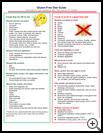
Non-Celiac Gluten Sensitivity
________________________________________________________________________
KEY POINTS
- Gluten is a protein found in wheat, rye, barley, and some other grains and foods. When your child has gluten sensitivity or intolerance, your child has a reaction, such as upset stomach or gas, after eating foods that contain gluten.
- Gluten sensitivity is treated with a gluten-free diet. A gluten-free diet contains no wheat, barley, or rye. Fresh fruits, vegetables, beans, milk, fresh beef, pork, poultry, fish, and eggs do not contain gluten. Nuts, seeds, and vegetable oils without additives are also safe.
- For most people, this diet relieves symptoms in a few weeks.
________________________________________________________________________
What is non-celiac gluten sensitivity?
Gluten is a protein found in wheat, rye, barley, and some other grains and foods. When your child has gluten sensitivity or intolerance, your child has a reaction, such as upset stomach or gas, after eating foods that contain gluten.
Gluten sensitivity is not the same as an allergy or celiac disease. If your child has an allergy to wheat, rye, or barley, eating these foods can cause hives, swelling, dizziness, or trouble breathing. If your child has celiac disease, eating gluten damages the lining of the small intestine and makes it hard for your child’s intestines to absorb nutrients from food.
What is the cause?
The exact cause of non-celiac gluten sensitivity is not known.
What are the symptoms?
Some people start having symptoms as children, others start having symptoms later in life. The symptoms vary a lot from one person to the next.
Digestive symptoms may include:
- Belly pain or cramps
- Gas and bloating
- Diarrhea or constipation
Other symptoms may happen hours or days after your child eats gluten and involve other parts of the body. These symptoms may include:
- Feeling unusually tired
- Headache
- Joint pain
- Numbness in the legs, arms, or fingers
- Trouble focusing and concentrating
How is it diagnosed?
Your healthcare provider will ask about your child’s symptoms and medical history and examine your child. There is no test for gluten sensitivity. Your child may have tests to check for other problems such as allergies or celiac disease. These tests may include:
- Blood tests
- Biopsy, which is the removal of a small sample of tissue from the intestine for testing
If these tests are normal, your provider may suggest that your child stop eating any foods that contain gluten to see if symptoms get better. If your child’s symptoms do get better, your provider may want your child to try food with gluten again to see if symptoms come back.
How is it treated?
The only treatment for gluten sensitivity is a gluten-free diet. For most children, this diet relieves symptoms in a few weeks.
What is a gluten-free diet?
A gluten-free diet contains no wheat, barley, or rye. Because the American diet is based on grains and many processed foods contain grain-based additives, this diet can be hard to follow. You may need to work with a dietitian to help your child eat a healthy, gluten-free diet. Here are some suggestions:
- Grains are high in carbohydrates (carbs) which are a source of energy and nutrients. Choose carbs made from rice, quinoa, millet, corn, and potatoes. Do not give your child carbs made from wheat, rye, and barley. Fresh fruits, vegetables, beans, milk, fresh beef, pork, poultry, fish, and eggs do not contain gluten. Nuts, seeds, and vegetable oils without additives are also safe.
- Any product with a “gluten-free” label is usually OK to eat. Some food products are certified by the Gluten Free Certification Organization (GFCO) and have a GFCO stamp on them. The GFCO tests for gluten in a product and has strict standards.
- Always read labels to check for gluten. Remember that "wheat-free" doesn't always mean "gluten-free." Wheat-free products may contain barley or rye.
- Many companies will send you a list of their gluten-free products. If you are not sure if a food contains gluten, your child should avoid the product until you check with the manufacturer.
- Some grocery stores offer a list of gluten-free products at the customer service desk or on their website.
- When you eat at a restaurant or deli, ask if they have a gluten-free menu. Help your child choose foods without sauces because wheat flour is used as a thickener in many sauces.
- Check with your child’s school cafeteria to see if they have gluten-free food options.
Your healthcare provider may prescribe a daily gluten-free multivitamin and mineral supplement. Ask your pharmacist or call the manufacturer to find out about the ingredients in your child’s medicine.
Ask your healthcare provider:
- How and when you will get your child’s test results
- How to take care of your child at home
- What symptoms or problems you should watch for and what to do if your child has them
Make sure you know when your child should come back for a checkup.
Last modified: 2021-03-09
Last reviewed: 2019-09-12

